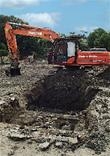Contaminated Land
Land contamination typically arises from historical activities, which occurred at a time when there was less awareness or regulation to control or clean up substances entering our environment.

Such activities includes engineering works, mining, quarrying and waste disposal which may have left some sites with contamination issues which need to be addressed. In order to tackle this legacy of historical contamination, the contaminated land regime was introduced in Scotland through Part I IA of the Environmental Protection Act 1990. This requires the council to undertake a series of specific functions including inspecting its land for potential contamination which are set out in the Scottish Government Statutory Guidance Edition 2 (PDF, 795 KB)(opens new window).
Land Contamination and Development Management
Scottish Government Planning Advice Note 33 (opens new window) notes the responsibility for the safe development of a site rests with the developer.
Failure to carry out appropriate assessment and remediation whilst developing a site may result in its determination as contaminated land under the regulations and remediation actions will be enforced by the council. In such a scenario, it is likely to be the developer, rather than the original polluter who would be considered the responsible party for introducing receptors to the pollution source and completing a pollutant linkage.
The following documents are designed to help developers and their consultants know what the council expects when dealing with land contamination:
- West Lothian Council supplementary planning guidance:
Development of Land Potentially Affected by Contamination (PDF, 433 KB)(opens new window)
- West Lothian Council Contaminated Land Strategy 2001
Contaminated Land Strategy 2001 (PDF, 89 KB)(opens new window)
- Scottish Contaminated Land Regulatory Officers:
An Introduction to Land Contamination and Development Management (PDF, 826 KB)(opens new window)
Further assistance and advice can be found on SEPA's web pages (opens new window)
Any requests for information on contaminated land can be made through an Environmental Information Request.



